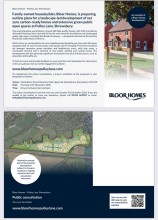On Monday 3rd November, the Bayston Hill Parish Council Planning Committee again objected to application 24/00765/FUL for 108 dwellings on Lyth Hill.
The committee voted unanimously to submit the following;
24/00765/FUL Hybrid planning application seeking (a) full planning permission for the creation of 108 dwellings, open space and infrastructure with access from Lyth Hill Road and (b) outline planning permission for up to 4no. serviced self-build plots (Amended description).
The revisions to application 24/00765/FUL remains contrary to the Shropshire Local Plan policies CS6 (Sustainable Design and Development Principles), MD2 (Sustainable Development), and the National Planning Policy Framework (NPPF paragraphs 125 and 135b). The proposal continues to exhibit excessive density, loss of best and most versatile agricultural land, inadequate open space provision, harmful landscape and light impacts, and adverse implications for local services and highway safety.
1. Density and Character – Conflict with MD2 and CS6
The proposed 108 dwellings and 4 self-build plots equate to a density of 26 dwellings per hectare, representing a 37% uplift over the Bayston Hill average of 19 dwellings per hectare. This level of intensification is inconsistent with the village’s established form, scale, and layout.
It therefore fails to comply with Policy MD2 (2.i), which requires development to respect local character, and NPPF paragraph 135(b), which seeks designs that are visually attractive and contextually appropriate. The development would cause significant harm to the character and appearance of the area, contrary to Policies CS6 and MD2.
2. Loss of Best and Most Versatile Agricultural Land
The revised scheme would still result in the loss of 2.3 hectares (38%) of best and most versatile agricultural land. This represents a substantial and unjustified loss of valuable farmland, conflicting with national and local objectives to safeguard such resources and ensure the efficient use of land. The latest document submitted on 14.10.2025 by the Agent with regards to Best and Most Versatile [BMV] Agricultural Land, if this approach was taken where every application involved the loss of BMV Agricultural land the numbers would add up and would be significant.
3. Public Open Space – Inaccessible and Poorly Integrated
Although the developer claims a 29% increase in public open space (from 1.39 to 1.80 hectares), this uplift is not clearly demonstrated in the revised plans (1555-08-02-114 Rev E vs Rev B).
Most open space remains on the periphery of the site rather than being distributed within the development, limiting accessibility and usability. The proposal fails to provide safe, overlooked, and functional play and recreation areas, as required by Policy MD2 (13.3) and NPPF guidance. A reduction in housing density would allow for more meaningful and integrated open space provision.
4. Light Pollution and Landscape Impact
The site occupies an elevated hillside currently characterised by dark rural surroundings. Introducing street and domestic lighting here would cause skyglow and light spill visible across the valley, harming visual amenity, tranquillity, and nocturnal wildlife. This conflicts with NPPF paragraph 125, which seeks to protect intrinsically dark landscapes from inappropriate illumination.
5. High Visual Impact (Zone of Theoretical Visibility)
The developer’s own Zone of Theoretical Visibility analysis (Tyler Grange drawing 15040/P02a, Feb 2024) identifies the site as an area of High Potential Visibility within a 5km radius. With ridge heights of 8.5–10.0m, the development would be even more prominent than indicated, increasing its adverse visual impact and urbanising the rural skyline.
6. Additional Concerns
- The site lies outside the defined Village Development Boundary.
- The development does not adequately mitigate its impact on local services and infrastructure.
- The proposal would introduce approximately 236 additional vehicles onto Lyth Hill Road and the A49 junction, exacerbating existing pedestrian and traffic safety concerns.
Conclusion
The latest revisions—reduction of six plots (has only reduced the density by 6%) —does not overcome the fundamental issues of excessive density (80 properties would be in line with the current density of Bayston Hill), harming the existing character of the village, the loss of BMV agricultural land, and light pollution.
Nothing has been changed in this revision to satisfactorily improve the quality and accessibility of the open space for the residents of this development.
Given the high potential visibility, landscape sensitivity, and conflict with Policies CS6, MD2, and NPPF paragraphs 125 and 135b, the proposal fails to deliver a sustainable or well-designed extension to Bayston Hill.
The Northern Planning Committee asked the Officers and the Developer to address these issues which has clearly not been achieved and for all the reasons above, the application should be refused.


